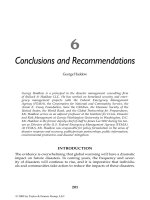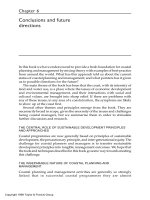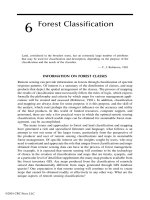Opration management chapter 6 inventory manageement
Bạn đang xem bản rút gọn của tài liệu. Xem và tải ngay bản đầy đủ của tài liệu tại đây (739.58 KB, 69 trang )
Operations
Management
Session 6 –
Inventory Management
© 2008 Prentice Hall, Inc.
12 – 1
Learning Objectives
When you complete this chapter you
should be able to:
1.
2.
3.
Conduct an ABC analysis
Explain and use cycle counting
Explain and use the EOQ model for
independent inventory demand
4. Compute a reorder point and safety
stock
© 2008 Prentice Hall, Inc.
12 – 2
Learning Objectives
When you complete this chapter you
should be able to:
5. Apply the production order quantity
model
6. Explain and use the quantity
discount model
7. Understand service levels and
probabilistic inventory models
© 2008 Prentice Hall, Inc.
12 – 3
Amazon.com
Amazon.com started as a “virtual”
retailer – no inventory, no
warehouses, no overhead; just
computers taking orders to be filled
by others
Growth has forced Amazon.com to
become a world leader in
warehousing and inventory
management
© 2008 Prentice Hall, Inc.
12 – 4
Amazon.com
1. Each order is assigned by computer to
the closest distribution center that has
the product(s)
2. A “flow meister” at each distribution
center assigns work crews
3. Lights indicate products that are to be
picked and the light is reset
4. Items are placed in crates on a conveyor.
Bar code scanners scan each item 15
times to virtually eliminate errors.
© 2008 Prentice Hall, Inc.
12 – 5
Amazon.com
5. Crates arrive at central point where items
are boxed and labeled with new bar code
6. Gift wrapping is done by hand at 30
packages per hour
7. Completed boxes are packed, taped,
weighed and labeled before leaving
warehouse in a truck
8. Order arrives at customer within a week
© 2008 Prentice Hall, Inc.
12 – 6
Inventory
One of the most expensive assets
of many companies representing as
much as 50% of total invested
capital
Operations managers must balance
inventory investment and customer
service
© 2008 Prentice Hall, Inc.
12 – 7
Functions of Inventory
1. To decouple or separate various
parts of the production process
2. To decouple the firm from
fluctuations in demand and
provide a stock of goods that will
provide a selection for customers
3. To take advantage of quantity
discounts
4. To hedge against inflation
© 2008 Prentice Hall, Inc.
12 – 8
Types of Inventory
Raw material
Purchased but not processed
Work-in-process
Undergone some change but not completed
A function of cycle time for a product
Maintenance/repair/operating (MRO)
Necessary to keep machinery and processes
productive
Finished goods
Completed product awaiting shipment
© 2008 Prentice Hall, Inc.
12 – 9
The Material Flow Cycle
Cycle time
95%
Input
Wait for
inspection
Wait to Move
be moved time
5%
Wait in queue
for operator
Setup
time
Run
time
Output
Figure 12.1
© 2008 Prentice Hall, Inc.
12 – 10
Inventory Management
How inventory items can be
classified
How accurate inventory records
can be maintained
© 2008 Prentice Hall, Inc.
12 – 11
ABC Analysis
Divides inventory into three classes
based on annual dollar volume
Class A - high annual dollar volume
Class B - medium annual dollar
volume
Class C - low annual dollar volume
Used to establish policies that focus
on the few critical parts and not the
many trivial ones
© 2008 Prentice Hall, Inc.
12 – 12
ABC Analysis
Item
Stock
Number
#10286
Percent of
Number of
Items
Stocked
20%
Annual
Volume
(units)
1,000
x
Unit
Cost
$ 90.00
=
Annual
Dollar
Volume
$ 90,000
Percent of
Annual
Dollar
Volume
Class
38.8%
A
72%
#11526
500
154.00
77,000
33.2%
A
#12760
1,550
17.00
26,350
11.3%
B
350
42.86
15,001
6.4%
1,000
12.50
12,500
5.4%
#10867
#10500
© 2008 Prentice Hall, Inc.
30%
23%
B
B
12 – 13
ABC Analysis
Item
Stock
Number
Percent of
Number of
Items
Stocked
Annual
Volume
(units)
x
Unit
Cost
=
Annual
Dollar
Volume
Percent of
Annual
Dollar
Volume
Class
#12572
600
$ 14.17
$ 8,502
3.7%
C
#14075
2,000
.60
1,200
.5%
C
100
8.50
850
.4%
#01307
1,200
.42
504
.2%
C
#10572
250
.60
150
.1%
C
$232,057
100.0%
#01036
50%
8,550
© 2008 Prentice Hall, Inc.
5%
C
12 – 14
Percent of annual dollar usage
ABC Analysis
80
70
60
50
40
30
20
10
0
A Items
–
–
–
–
–
–
–
B Items
–
|
|
|
– |
10 20 30 40
C Items
|
|
|
|
|
|
50
60
70
80
90
100
Percent of inventory items
© 2008 Prentice Hall, Inc.
Figure 12.2
12 – 15
ABC Analysis
Other criteria than annual dollar
volume may be used
Anticipated engineering changes
Delivery problems
Quality problems
High unit cost
© 2008 Prentice Hall, Inc.
12 – 16
ABC Analysis
Policies employed may include
More emphasis on supplier
development for A items
Tighter physical inventory control for
A items
More care in forecasting A items
© 2008 Prentice Hall, Inc.
12 – 17
Record Accuracy
Accurate records are a critical
ingredient in production and inventory
systems
Allows organization to focus on what
is needed
Necessary to make precise decisions
about ordering, scheduling, and
shipping
Incoming and outgoing record
keeping must be accurate
Stockrooms should be secure
© 2008 Prentice Hall, Inc.
12 – 18
Control of Service
Inventories
Can be a critical component
of profitability
Losses may come from
shrinkage or pilferage
Applicable techniques include
1. Good personnel selection, training, and
discipline
2. Tight control on incoming shipments
3. Effective control on all goods leaving
facility
© 2008 Prentice Hall, Inc.
12 – 19
Holding, Ordering, and
Setup Costs
Holding costs - the costs of holding
or “carrying” inventory over time
Ordering costs - the costs of
placing an order and receiving
goods
Setup costs - cost to prepare a
machine or process for
manufacturing an order
© 2008 Prentice Hall, Inc.
12 – 20
Holding Costs
Category
Housing costs (building rent or
depreciation, operating costs, taxes,
insurance)
Cost (and range)
as a Percent of
Inventory Value
6%
(3 - 10%)
Material handling costs (equipment lease or
3%
depreciation, power, operating cost)
(1 - 3.5%)
Labor cost
3%
(3 - 5%)
Investment costs (borrowing costs, taxes,
11%
and insurance on inventory)
(6 - 24%)
Pilferage, space, and obsolescence
3%
(2 - 5%)
Overall carrying cost
26%
Table 12.1
© 2008 Prentice Hall, Inc.
12 – 21
Holding Costs
Cost (and range)
as a Percent of
Inventory Value
Category
ing
d
n
e
p
e
d
y
l
b
Housing costs (building rrent
ornsidera
6%tes.
o
c
y
a
a
v
r
t
s
t
s
s
e
r
o
e
c
t
n
depreciation,
operating
costs,
taxes,
(3
10%)
g
i
n
i
d
d
n
l
a
Ho
ion,
t
a
c
o
l
,
tech
s
s
h
e
insurance)
g
n
i
i
h
s
u
e
b
m
e
o
h
s
t
,
on
5%
1
n
a
h
t
r
%.
e
0
t
5
a
e
n
r
a
g
h
t
y
l
r
l
e
Material
handling
costs
(equipment
lease
or
3%
a
t
r
grea
Gene
s
t
s
o
c
g
n
i
d
l
depreciation,
power,
cost)
(1 - 3.5%)
hooperating
items have
Labor cost
Investment costs (borrowing costs, taxes,
and insurance on inventory)
Pilferage, space, and obsolescence
Overall carrying cost
© 2008 Prentice Hall, Inc.
3%
(3 - 5%)
11%
(6 - 24%)
3%
(2 - 5%)
26%
Table 12.1
12 – 22
Inventory Models for
Independent Demand
Need to determine when and how
much to order
Basic economic order quantity
Production order quantity
Quantity discount model
© 2008 Prentice Hall, Inc.
12 – 23
Basic EOQ Model
Important assumptions
1. Demand is known, constant, and
independent
2. Lead time is known and constant
3. Receipt of inventory is instantaneous and
complete
4. Quantity discounts are not possible
5. Only variable costs are setup and holding
6. Stockouts can be completely avoided
© 2008 Prentice Hall, Inc.
12 – 24
Inventory level
Inventory Usage Over Time
Usage rate
Order
quantity = Q
(maximum
inventory
level)
Average
inventory
on hand
Q
2
Minimum
inventory
0
Time
Figure 12.3
© 2008 Prentice Hall, Inc.
12 – 25









